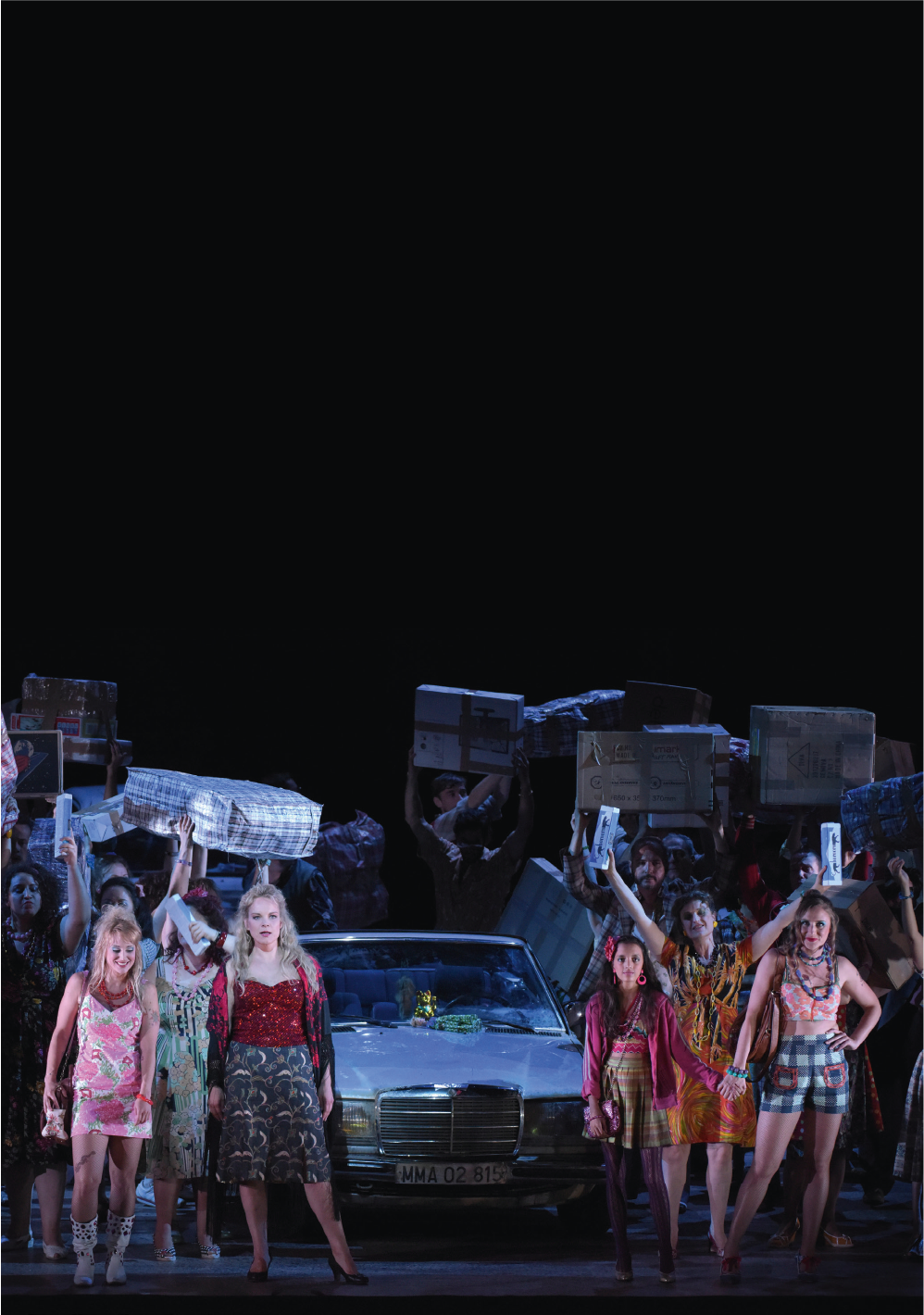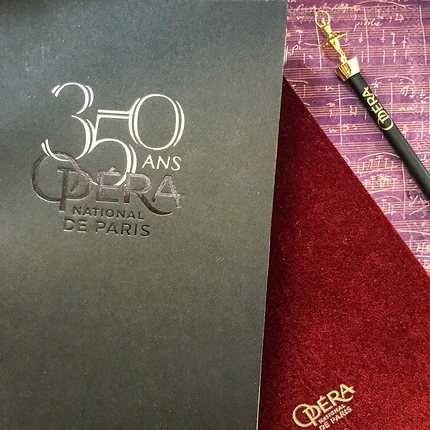Synopsis
An air of Russia pervades this evening of dance which combines two great repertoire classics and a new work. Frederick Ashton’s Rhapsody honours the classical tradition to a lively and colourful score by the Russian composer Rachmaninov. Former dancer and artistic collaborator of the Batsheva Dance Company, Sharon Eyal reinterprets an emblematic work of the Ballets Russes, L’Après-midi d’un faune, in her first creation for the dancers of the Paris Opera Ballet, to music inspired by Debussy. Last performed in 1995, Nijinsky’s The Rite of Spring returns to the stage of the Paris Opera, offering us scenes from pagan Russia to Stravinsky’s compelling music.
Duration : 1h47 with 1 interval
-
Opening
-
First part 42 min
-
Intermission 30 min
-
Second part 35 min
-
End
Artists
Creative team
Cast
- Monday 29 November 2021 at 19:30
- Wednesday 01 December 2021 at 19:30
- Thursday 02 December 2021 at 19:30
- Friday 03 December 2021 at 19:30
- Saturday 04 December 2021 at 20:00
- Sunday 05 December 2021 at 14:30
- Tuesday 07 December 2021 at 19:30
- Thursday 09 December 2021 at 19:30
- Friday 10 December 2021 at 19:30
- Saturday 11 December 2021 at 20:00
- Sunday 12 December 2021 at 20:00
- Tuesday 14 December 2021 at 19:30
- Thursday 16 December 2021 at 19:30
- Saturday 18 December 2021 at 20:00
- Monday 20 December 2021 at 19:30
- Wednesday 22 December 2021 at 19:30
- Thursday 23 December 2021 at 19:30
- Friday 24 December 2021 at 19:30
- Saturday 25 December 2021 at 19:30
- Monday 27 December 2021 at 19:30
- Wednesday 29 December 2021 at 19:30
- Friday 31 December 2021 at 19:30
- Saturday 01 January 2022 at 19:30
- Sunday 02 January 2022 at 14:30
Latest update 31 December 2021, cast is likely to change.
Latest update 31 December 2021, cast is likely to change.
Latest update 31 December 2021, cast is likely to change.
Latest update 31 December 2021, cast is likely to change.
Latest update 31 December 2021, cast is likely to change.
Latest update 31 December 2021, cast is likely to change.
Latest update 31 December 2021, cast is likely to change.
Latest update 31 December 2021, cast is likely to change.
Latest update 31 December 2021, cast is likely to change.
Latest update 31 December 2021, cast is likely to change.
Latest update 31 December 2021, cast is likely to change.
Latest update 31 December 2021, cast is likely to change.
Latest update 31 December 2021, cast is likely to change.
Latest update 31 December 2021, cast is likely to change.
Latest update 31 December 2021, cast is likely to change.
Latest update 31 December 2021, cast is likely to change.
Latest update 31 December 2021, cast is likely to change.
Latest update 31 December 2021, cast is likely to change.
Latest update 31 December 2021, cast is likely to change.
Latest update 31 December 2021, cast is likely to change.
Latest update 31 December 2021, cast is likely to change.
Latest update 31 December 2021, cast is likely to change.
Latest update 31 December 2021, cast is likely to change.
Latest update 31 December 2021, cast is likely to change.
Creation
Creative team
Cast
- Monday 29 November 2021 at 19:30
- Wednesday 01 December 2021 at 19:30
- Thursday 02 December 2021 at 19:30
- Friday 03 December 2021 at 19:30
- Saturday 04 December 2021 at 20:00
- Sunday 05 December 2021 at 14:30
- Tuesday 07 December 2021 at 19:30
- Thursday 09 December 2021 at 19:30
- Friday 10 December 2021 at 19:30
- Saturday 11 December 2021 at 20:00
- Sunday 12 December 2021 at 20:00
- Tuesday 14 December 2021 at 19:30
- Thursday 16 December 2021 at 19:30
- Saturday 18 December 2021 at 20:00
- Monday 20 December 2021 at 19:30
- Wednesday 22 December 2021 at 19:30
- Thursday 23 December 2021 at 19:30
- Friday 24 December 2021 at 19:30
- Saturday 25 December 2021 at 19:30
- Monday 27 December 2021 at 19:30
- Wednesday 29 December 2021 at 19:30
- Friday 31 December 2021 at 19:30
- Saturday 01 January 2022 at 19:30
- Sunday 02 January 2022 at 14:30
Latest update 31 December 2021, cast is likely to change.
Latest update 31 December 2021, cast is likely to change.
Latest update 31 December 2021, cast is likely to change.
Latest update 31 December 2021, cast is likely to change.
Latest update 31 December 2021, cast is likely to change.
Latest update 31 December 2021, cast is likely to change.
Latest update 31 December 2021, cast is likely to change.
Latest update 31 December 2021, cast is likely to change.
Latest update 31 December 2021, cast is likely to change.
Latest update 31 December 2021, cast is likely to change.
Latest update 31 December 2021, cast is likely to change.
Latest update 31 December 2021, cast is likely to change.
Latest update 31 December 2021, cast is likely to change.
Latest update 31 December 2021, cast is likely to change.
Latest update 31 December 2021, cast is likely to change.
Latest update 31 December 2021, cast is likely to change.
Latest update 31 December 2021, cast is likely to change.
Latest update 31 December 2021, cast is likely to change.
Latest update 31 December 2021, cast is likely to change.
Latest update 31 December 2021, cast is likely to change.
Latest update 31 December 2021, cast is likely to change.
Latest update 31 December 2021, cast is likely to change.
Latest update 31 December 2021, cast is likely to change.
Latest update 31 December 2021, cast is likely to change.
New production in agreement with the Vaslav and Romola Nijinski Estate.
Creative team
Cast
- Monday 29 November 2021 at 19:30
- Wednesday 01 December 2021 at 19:30
- Thursday 02 December 2021 at 19:30
- Friday 03 December 2021 at 19:30
- Saturday 04 December 2021 at 20:00
- Sunday 05 December 2021 at 14:30
- Tuesday 07 December 2021 at 19:30
- Thursday 09 December 2021 at 19:30
- Friday 10 December 2021 at 19:30
- Saturday 11 December 2021 at 20:00
- Sunday 12 December 2021 at 20:00
- Tuesday 14 December 2021 at 19:30
- Thursday 16 December 2021 at 19:30
- Saturday 18 December 2021 at 20:00
- Monday 20 December 2021 at 19:30
- Wednesday 22 December 2021 at 19:30
- Thursday 23 December 2021 at 19:30
- Friday 24 December 2021 at 19:30
- Saturday 25 December 2021 at 19:30
- Monday 27 December 2021 at 19:30
- Wednesday 29 December 2021 at 19:30
- Friday 31 December 2021 at 19:30
- Saturday 01 January 2022 at 19:30
- Sunday 02 January 2022 at 14:30
Latest update 31 December 2021, cast is likely to change.
Latest update 31 December 2021, cast is likely to change.
Latest update 31 December 2021, cast is likely to change.
Latest update 31 December 2021, cast is likely to change.
Latest update 31 December 2021, cast is likely to change.
Latest update 31 December 2021, cast is likely to change.
Latest update 31 December 2021, cast is likely to change.
Latest update 31 December 2021, cast is likely to change.
Latest update 31 December 2021, cast is likely to change.
Latest update 31 December 2021, cast is likely to change.
Latest update 31 December 2021, cast is likely to change.
Latest update 31 December 2021, cast is likely to change.
Latest update 31 December 2021, cast is likely to change.
Latest update 31 December 2021, cast is likely to change.
Latest update 31 December 2021, cast is likely to change.
Latest update 31 December 2021, cast is likely to change.
Latest update 31 December 2021, cast is likely to change.
Latest update 31 December 2021, cast is likely to change.
Latest update 31 December 2021, cast is likely to change.
Latest update 31 December 2021, cast is likely to change.
Latest update 31 December 2021, cast is likely to change.
Latest update 31 December 2021, cast is likely to change.
Latest update 31 December 2021, cast is likely to change.
Latest update 31 December 2021, cast is likely to change.
Les Étoiles, les Premiers Danseurs et le Corps de Ballet
Orchestre de l’Opéra national de Paris
Media
Access and services
Palais Garnier
Place de l'Opéra
75009 Paris
Public transport
Underground Opéra (lignes 3, 7 et 8), Chaussée d’Antin (lignes 7 et 9), Madeleine (lignes 8 et 14), Auber (RER A)
Bus 20, 21, 27, 29, 32, 45, 52, 66, 68, 95, N15, N16
Calculate my routeAt the Palais Garnier, buy €10 tickets for seats in the 6th category (very limited visibility, two tickets maximum per person) on the day of the performance at the Box offices.
In both our venues, discounted tickets are sold at the box offices from 30 minutes before the show:
- €25 tickets for under-28s, unemployed people (with documentary proof less than 3 months old) and senior citizens over 65 with non-taxable income (proof of tax exemption for the current year required)
- €40 tickets for senior citizens over 65
Get samples of the operas and ballets at the Paris Opera gift shops: programmes, books, recordings, and also stationery, jewellery, shirts, homeware and honey from Paris Opera.
Palais Garnier
- Every day from 10:30 a.m. to 6 p.m. and until performances end
- Get in from Place de l’Opéra or from within the theatre’s public areas
- For more information: +33 1 53 43 03 97
Online
Palais Garnier
Place de l'Opéra
75009 Paris
Public transport
Underground Opéra (lignes 3, 7 et 8), Chaussée d’Antin (lignes 7 et 9), Madeleine (lignes 8 et 14), Auber (RER A)
Bus 20, 21, 27, 29, 32, 45, 52, 66, 68, 95, N15, N16
Calculate my routeAt the Palais Garnier, buy €10 tickets for seats in the 6th category (very limited visibility, two tickets maximum per person) on the day of the performance at the Box offices.
In both our venues, discounted tickets are sold at the box offices from 30 minutes before the show:
- €25 tickets for under-28s, unemployed people (with documentary proof less than 3 months old) and senior citizens over 65 with non-taxable income (proof of tax exemption for the current year required)
- €40 tickets for senior citizens over 65
Get samples of the operas and ballets at the Paris Opera gift shops: programmes, books, recordings, and also stationery, jewellery, shirts, homeware and honey from Paris Opera.
Palais Garnier
- Every day from 10:30 a.m. to 6 p.m. and until performances end
- Get in from Place de l’Opéra or from within the theatre’s public areas
- For more information: +33 1 53 43 03 97
Online
You will also like
Partners
-
With the support of the Cercle Noverre



































































































